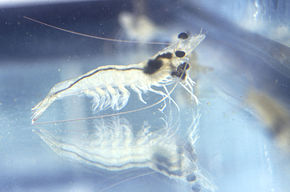Prawn
| Dendrobranchiata | ||||||||||||
|---|---|---|---|---|---|---|---|---|---|---|---|---|
 Litopenaeus vannamei
|
||||||||||||
| Scientific classification | ||||||||||||
|
||||||||||||
| Superfamilies and families | ||||||||||||
|
Penaeoidea
Sergestoidea
|
Prawns are crustaceans, belonging to the sub-order Dendrobranchiata [1]. They are similar in appearance to shrimp, but can be distinguished by the gill structure which is branching in prawns (hence the name, dendro=“tree”; branchia=“gill”), but is lamellar in shrimp. The sister taxon to Dendrobranchiata is Pleocyemata, which contains all the true shrimp, crabs, lobsters, etc.
Contents |
Commercial and culinary use
In commercial farming and fishery, the terms prawn and shrimp are generally used interchangeably. In European countries, particularly the United Kingdom, the word “prawns” is far more common on menus than the term “shrimp”, which is generally only used in North America. The term “prawn” is also loosely used to describe any large shrimp, especially those that come 15 (or fewer) to the pound (also called “king prawns”). Australia and other Commonwealth countries including South Africa follow this European/British use to an even greater extent, using the word “prawn” almost exclusively. In Spain, gambas al ajillo (translated to garlic prawns) is a popular dish with both the locals and tourists, traditionally served as tapas. In South Asia and Southeast Asia, prawn curry is a very popular dish.
In Britain very small crustaceans with a brownish shell, about 1cm long or smaller when shelled, are called specifically shrimp. They are sometimes added to dishes not based mainly on them, and used to make potted shrimp.
Etymology
In various forms of English, the name “prawn” is often applied to shrimp as well, generally the larger species, such as Leander serratus. In the United States, according to the 1911 Encyclopædia Britannica, the word “prawn” usually indicates a freshwater shrimp or prawn. In Middle English, the word “prawn” is recorded as prayne or prane; no cognate form can be found in any other language. It has often been connected to the Latin perna, a ham-shaped shellfish, but this is due to an old scholarly error that connected perna and parnocchie with prawne-fishes or shrimps. In fact, the Old Italian perna and pernocchia meant a shellfish that yielded nacre, or mother-of-pearl.
See also
- Scampi
- Shrimp fishery
- Shrimp farming
- Freshwater prawn farm
References
- ↑ Burkenroad, M. D. (1963). "The evolution of the Eucarida (Crustacea, Eumalacostraca), in relation to the fossil record". Tulane Studies in Geology 2 (1): 1–17.